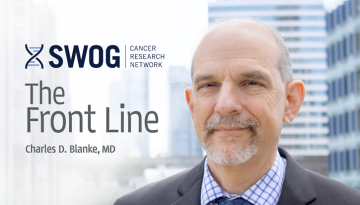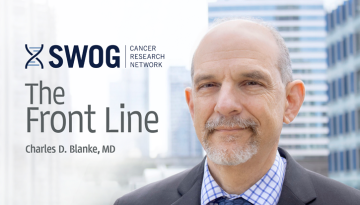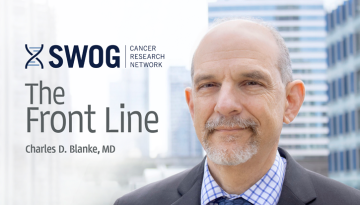Cancer Trials Adapted Rapidly During Pandemic
Cancer clinical trial research rapidly adapted to the circumstances of enrolling and treating patients on clinical trials during the COVID-19 pandemic. That’s the conclusion drawn by authors of a study of cancer trial enrollment during 2020 and early 2021. The findings are published today in the medical journal JAMA Network Open.
The study reports on pandemic enrollment to protocols run by the SWOG Cancer Research Network, a cancer clinical trials group funded by the National Cancer Institute (NCI), part of the National Institutes of Health. The researchers found that during the early weeks of the pandemic, from late February through mid-April 2020, registrations to cancer clinical trials dropped precipitously compared to previous years. This drop was followed by an initial recovery period lasting through the summer of 2020; in fact by the end of the summer, enrollment totals actually slightly exceeded what would have been expected without the pandemic. Enrollments again dropped during the wave of increasing COVID-19 infections in the winter of 2020/2021, but much more modestly compared to the initial wave of the pandemic.
To assess changes in trial registration rates, investigators led by Joseph Unger, PhD, a SWOG health services researcher and biostatistician based at the Fred Hutchinson Cancer Research Center, used interrupted time-series analysis to compare pandemic enrollment rates to expected rates based on data from the four previous years. A total of 29,398 patients were enrolled to SWOG trials from January 1, 2016, through February 28, 2021. About two-thirds of these enrollments were to treatment trials, with the remaining one-third to cancer control and prevention studies.
Unger explained that early in the pandemic, the NCI and Food and U.S. Drug Administration had provided guidance allowing research sites more flexibility in enrolling and following patients on trials. Key recommendations included allowing remote consent of patients and virtual visits.
“After the initial COVID-19 outbreak, we observed a dramatic drop-off in trial enrollments,” he noted. “Now a year later, we wanted to assess enrollment over an entire year of the pandemic, especially given the flexibilities that had been introduced into the system.”
Overall during the entire one-year pandemic period measured (March 2020 through February 2021), SWOG trials enrolled 5,344 participants, whereas an estimated 6,913 participants would have been enrolled had the pandemic not occurred. Particularly steep drops in enrollment were seen within cancer control and prevention studies, which registered only 54 percent of expected enrollments, while enrollment overall to treatment studies was 91 percent of expected.
“Remarkably, treatment trial enrollment was about the same as expected,” said Unger. “Clearly the steps taken to maintain trial research programs were successful. It really is a testament to the resiliency and resourcefulness of the physicians, nurses, and staffs at the sites.”
However, the researchers conjecture, the maintenance of near-normal overall enrollment levels to treatment trials over the course of the pandemic may have occurred at the expense of support for cancer control and prevention trials, as institutions prioritized resources to conduct trials most directly related to immediate patient care.
The authors also assessed relative changes in enrollment by patient age, sex, race, ethnicity, and state of residence. Enrollments dropped substantially in states hit harder by the pandemic, but overall enrollment numbers remained relatively unchanged in less hard hit states. Enrollments of Black and Hispanic patients to treatment trials did not fall significantly over the pandemic year. In contrast, cancer control trials saw reductions in enrollments for all demographic groups of patients, especially for Black and Hispanic patients. Researchers also observed that the decline in the enrollment of female patients to cancer control and prevention trials was notably greater than it was for male patients.
“It’s critical for individual patients to be able to continue to choose to receive care on trials if they wish to, even in the face of a pandemic,” added Unger. The researchers also indicated that the question of whether enrollment overall remained significantly reduced is an important one, because long-term drops in clinical trial accrual slow the development of new therapies for all cancer patients.
This work was supported in part by the NIH/NCI through grants CA189974, CA180888, and CA180819 and in part by The Hope Foundation for Cancer Research.
Authors on the study team included Hong Xiao, PhD, and Michael LeBlanc, PhD, both of the SWOG Statistics and Data Management Center at the Fred Hutchinson Cancer Research Center; Dawn L. Hershman, MD, of Columbia University Medical Center; and Charles D. Blanke, MD, of the SWOG Cancer Research Network Group Chair’s Office at the Oregon Health and Science University Knight Cancer Institute.
Other Recent Stories



